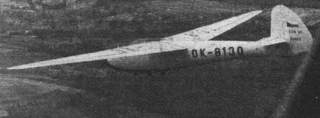
The Gregor FDB-1 was a Canadian biplane fighter, designed in 1938 by Michael Gregor and manufactured by Canadian Car and Foundry. Despite having some advanced design features such as flush rivetted all-metal construction and a retractable undercarriage, the final generation of biplane fighters was being supplanted by monoplanes and the Gregor FDB-1 was obsolete before it flew. Despite the Royal Canadian Air Force's desperation for modern fighters, the sole example remained unsold and was eventually lost in a fire in 1945. The Gregor FDB-1's model designation stood for Fighter Dive Bomber indicating its intended roles.

The Boeing Model 64 was an American single engine biplane training aircraft built by Boeing in the 1920s that failed to gain any orders.
The Fisher Youngster is a Canadian single-seat, conventional landing gear, single-engined, biplane kit aircraft designed for construction by amateur builders. The aircraft was inspired by the German Bücker Bü 133 Jungmeister aerobatic aircraft of the 1930s.

The Smith DSA-1 Miniplane is a single-seat, single-engine sport aircraft designed in the United States in the 1950s and marketed for home building.
The Nakajima P-1 was a 1930s Japanese single engine, single seat biplane intended for night mail flights, derived from the Nakajima E4N3 Naval reconnaissance seaplane. Nine were built.
The Explorer PG-1 Aqua Glider is an American single seat, biplane glider that was designed by Bill Skiliar in 1959 and made available as plans for amateur construction. The prototype was built with help from a troop of Air Explorer Scouts that same year.

The Stolp-Adams SA-100 Starduster is an American single-seat sport biplane designed to be built from plans supplied by Aircraft Spruce & Specialty Co. Though the first flight was in 1957, Stardusters continue to be built and flown.

The Midwest MU-1 was an American single-seat, high-wing, strut-braced utility glider that was designed by Arthur B. Schultz in the 1930s.

The EDRA Aeronautica Super Pétrel is an amphibious pusher configuration biplane, seating two side-by-side, brought into production in Brazil in 2002 though with French parentage. It remained in production in 2011, in kit and flyaway forms.
The Tisserand Hydroplum is a small amphibious aircraft with a single, pusher engine, built in France in the 1980s. Originally a single-seat, high-wing monoplane, it was developed into a two-seat biplane for production in kit form as the SMAN Pétrel.
The Jungster II is a parasol wing homebuilt aircraft. Designed by Rim Kaminskas, it first flew in March 1966.
The Normand Dube Aerocruiser Plus is a four-seat Canadian amateur-built aircraft, designed by Normand Dube and produced by Aviation Normand Dube of Sainte-Anne-des-Plaines, Quebec. The aircraft is a development of the two-seat Norman Dube Aerocruiser.
The Lie-Fang 1, some sources Jeifang 1, was one of the first gliders designed and built in China, though with Polish design input. It is an all-wood, two seat, intermediate training aircraft which first flew in 1958.

The Jameson RJJ-1 Gipsy Hawk was a single-engine light aircraft intended to be homebuilt from plans. The prototype was designed and constructed in the U.S. by Richard Jameson in the late 1960s-early 1970s.
The Aviator Shershen' is a Russian two seat biplane, sold in kit form. It first flew in 2005 and several variants have been produced, with a choice of engines.
The Bagalini Bagalini is an Italian homebuilt ultralight aircraft that was designed by Marino Bagalini. The aircraft is supplied in the form of plans for amateur construction.

The Zlín Šohaj series of club gliders began as a post World War II development of the DFS Olympia Meise. A large number were built in the 1940s and '50s.
The MMPL Kanpur was an Indian light four-seat aircraft, designed for service and agricultural work in the early 1960s. It is a rare example of an aircraft designed and built by a national air force for its own use.
The Larson F-12 Baby was a single engine, single seat sports biplane built in the US in the early 1960s. It was intended to produce it ready to fly or homebuilt from kits or plans but only one was completed.
The Lacroix-Trussant L.T.-51 Microplan was a French, low-powered, two seat amateur-built biplane. It flew just before the outbreak of World War II. After the war it was re-engined and flew until 1953.








